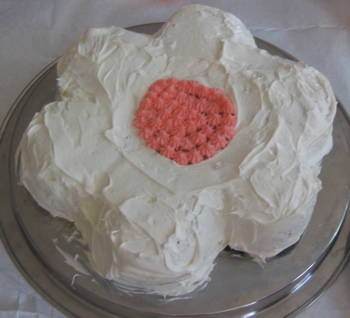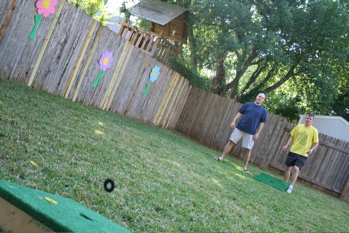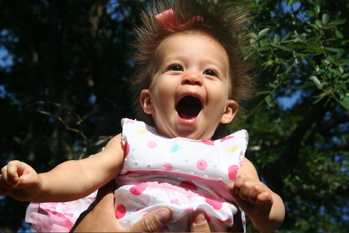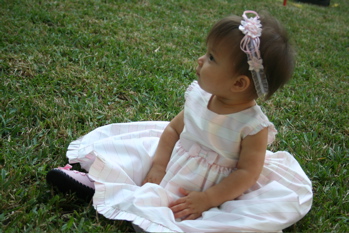
Mommy and Me Music Class
 Darah and I attended a Music Together class when she was 18 months old. It was one of the most enjoyable things I’ve done with Darah. In Music Together, we sang a lot of fun songs, did a lot of dancing and silly movements, played with cool instruments, and just had a really good time! The teacher encouraged the parents to get very involved during the classes, and we all just fed off the teacher’s high energy and zany personality. For the past six weeks, I have had the wonderful opportunity of attending a Kindermusik class with Darah (now 3 1/2) and Connor (17 months old). At first, I was going to attend with Darah only, but due to the difficulty in arranging sitting for him during our class, I decided to sign him up as well. Kindermusik is very similar to Music Together, however the Kindermusik class seemed to explore the body and movements while singing or listening to music, while Music Together seemed to explore the actual music more. I think you get just as much out of both of the programs, just a little different.
Darah and I attended a Music Together class when she was 18 months old. It was one of the most enjoyable things I’ve done with Darah. In Music Together, we sang a lot of fun songs, did a lot of dancing and silly movements, played with cool instruments, and just had a really good time! The teacher encouraged the parents to get very involved during the classes, and we all just fed off the teacher’s high energy and zany personality. For the past six weeks, I have had the wonderful opportunity of attending a Kindermusik class with Darah (now 3 1/2) and Connor (17 months old). At first, I was going to attend with Darah only, but due to the difficulty in arranging sitting for him during our class, I decided to sign him up as well. Kindermusik is very similar to Music Together, however the Kindermusik class seemed to explore the body and movements while singing or listening to music, while Music Together seemed to explore the actual music more. I think you get just as much out of both of the programs, just a little different.
 The first week of Kindermusik was difficult because Connor didn’t want to attend to anything we were doing and I was split between both children. If I think hard about it though, none of the children were perfectly attending to the class, so I think I probably was more stressed out about it than necessary. Since that first week, the kids have grown so much in their music exploration. Darah really never had much of a problem attending to the group songs and activities like Connor did, but she still has learned how to follow the direction of the teacher, move fast-and-slow, start-and-stop her instrument or movement, transition between songs and activities. Connor, though has grown up so much during our class. The first session, he threw major temper tantrums when it was time to transition. When we would put up the maracas, he would cry and run away with his maracas. When the teacher started singing her “drums away” song, he would grip his drum even harder while crying. I left thinking he just wasn’t mature enough for a group activity like Kindermusik. By week two, he got a little better about it, and even though I would have to pry each instrument away from him when it was time to transition, the crying didn’t turn into all out temper tantrums. By week three, though, he would start putting his instrument up when the teacher started singing the transition song. There were still tears, but he was following direction. Last week, he actually seemed to look forward to the transition to see what was coming next. He eyed the hoola hoops the whole time and every time the transition song would start, he’d clean up and run over to the hoola hoops, hoping this was the transition that was going to lead to them. There were still some tears, but he was in no way uncontrollable, and I loved that he was following direction so well.
The first week of Kindermusik was difficult because Connor didn’t want to attend to anything we were doing and I was split between both children. If I think hard about it though, none of the children were perfectly attending to the class, so I think I probably was more stressed out about it than necessary. Since that first week, the kids have grown so much in their music exploration. Darah really never had much of a problem attending to the group songs and activities like Connor did, but she still has learned how to follow the direction of the teacher, move fast-and-slow, start-and-stop her instrument or movement, transition between songs and activities. Connor, though has grown up so much during our class. The first session, he threw major temper tantrums when it was time to transition. When we would put up the maracas, he would cry and run away with his maracas. When the teacher started singing her “drums away” song, he would grip his drum even harder while crying. I left thinking he just wasn’t mature enough for a group activity like Kindermusik. By week two, he got a little better about it, and even though I would have to pry each instrument away from him when it was time to transition, the crying didn’t turn into all out temper tantrums. By week three, though, he would start putting his instrument up when the teacher started singing the transition song. There were still tears, but he was following direction. Last week, he actually seemed to look forward to the transition to see what was coming next. He eyed the hoola hoops the whole time and every time the transition song would start, he’d clean up and run over to the hoola hoops, hoping this was the transition that was going to lead to them. There were still some tears, but he was in no way uncontrollable, and I loved that he was following direction so well.
The last six weeks has been a very enjoyable time for me and my children. I am so glad that I didn’t find a babysitter for him during the music class and went ahead and signed him up as well. I’m sad that this session is finishing, but you better believe we’ll be signing up for another one!
I strongly recommend you find a Kindermusik or Music Together or Gymboree music class in your area to try. Most locations will let you try out a class for FREE!!
Have you been to a Mommy and Me Music class? What did you think? What other fun activities have you done with your baby or toddler?
Share the fun: Email + Del.icio.us + Digg + Technorati


 2. Every first birthday party must have cake! The theme of our party was flowers, so my husband made two cakes in the shape of a flower. We bought a cake flower pan at Hobby Lobby and used boxed cake mix. We didn’t have time to make a special small cake for Ace so I just cut off one of the petals for her to dig into. No one cared that she didn’t have a special cake to herself.
2. Every first birthday party must have cake! The theme of our party was flowers, so my husband made two cakes in the shape of a flower. We bought a cake flower pan at Hobby Lobby and used boxed cake mix. We didn’t have time to make a special small cake for Ace so I just cut off one of the petals for her to dig into. No one cared that she didn’t have a special cake to herself.


 Sign language has been an amazing communication tool for our family. Upon discovery that my daughter has Down syndrome, we were fairly certain that verbal communication was going to be delayed. As a result, we started teaching her sign language at a very young age. Darah is able to tell us when she is hungry, thirsty, hurt, sleepy, and when she wants a bath. She can also participate in “small talk” as well, by naming things she sees or wants like dogs, rain, stars, shoes, airplanes, and yogurt. Darah (at 3 1/2 years old) has over 200 signs now that she uses! Sign language has been such a gift for her and I am so happy that we introduced it to her! When Connor was born, signing was already part of our lives. Connor (now 15 months) learned signs pretty much by osmosis. I am surprised at the number of signs he’s learned just by observing Darah. The other day, Darah was in time-out and he decided to sit in time-out with her. When I allowed Darah to come out of time-out, he stood up and surprised me by signing “sorry.” I then drilled him some of Darah’s signs, and he knew “please,” “thank-you,” “dog,” and several other signs that I never once showed him. He also consistently uses “more,” “all done,” “eat,” “milk,” “bath,” and several other signs.
Sign language has been an amazing communication tool for our family. Upon discovery that my daughter has Down syndrome, we were fairly certain that verbal communication was going to be delayed. As a result, we started teaching her sign language at a very young age. Darah is able to tell us when she is hungry, thirsty, hurt, sleepy, and when she wants a bath. She can also participate in “small talk” as well, by naming things she sees or wants like dogs, rain, stars, shoes, airplanes, and yogurt. Darah (at 3 1/2 years old) has over 200 signs now that she uses! Sign language has been such a gift for her and I am so happy that we introduced it to her! When Connor was born, signing was already part of our lives. Connor (now 15 months) learned signs pretty much by osmosis. I am surprised at the number of signs he’s learned just by observing Darah. The other day, Darah was in time-out and he decided to sit in time-out with her. When I allowed Darah to come out of time-out, he stood up and surprised me by signing “sorry.” I then drilled him some of Darah’s signs, and he knew “please,” “thank-you,” “dog,” and several other signs that I never once showed him. He also consistently uses “more,” “all done,” “eat,” “milk,” “bath,” and several other signs.




